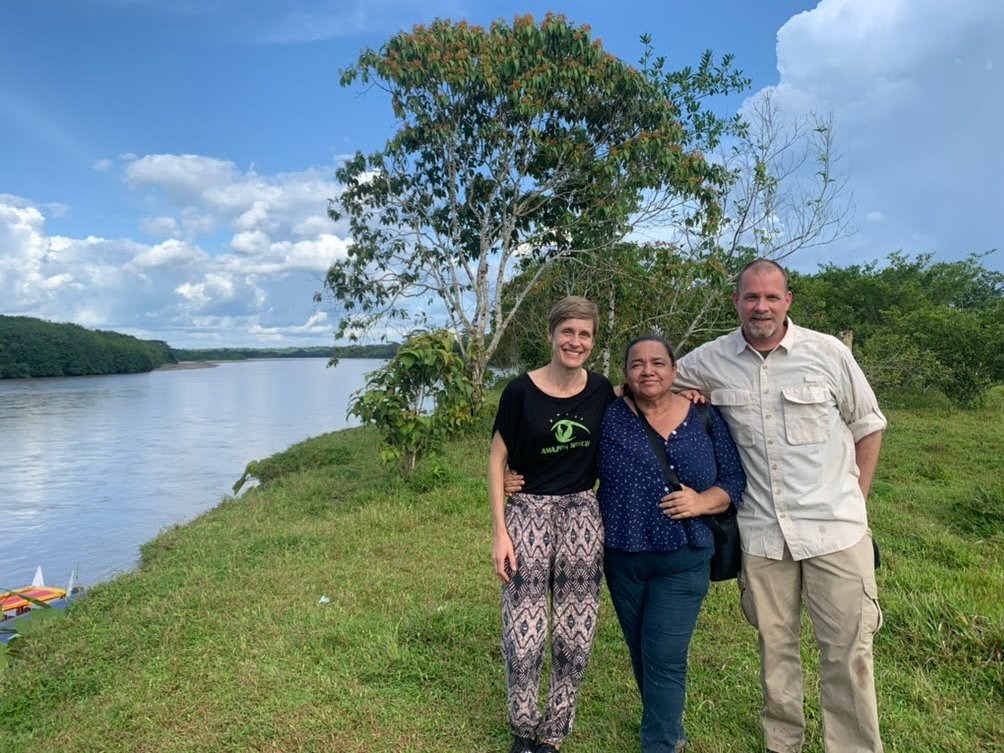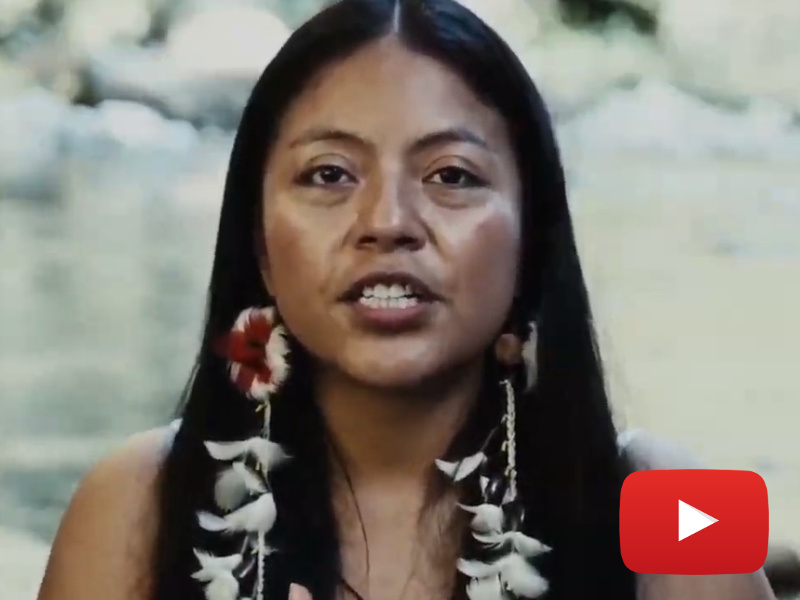The Putumayo River is a breathtaking and important artery in the Colombian Amazon. Unfortunately, it is also a dangerous place. Ripping over the water in a small speedboat as we passed jungle-lined shores, I was elated to finally meet Jani Silva, a community leader and environmental defender with whom we have been collaborating over the last year. Following virtual advocacy events Amazon Watch organized featuring Jani and an important essay about her in the New York Times, an Amazon Watch delegation — composed of Finance and Climate Director Moira Birss and myself — finally visited southern Colombia and accompanied Jani to her rural community, Pedregosa, in early May.
On the boat, I realized that Jani might not be sharing my exhilaration. The river is controlled by an illegal armed group heavily implicated in the drug trade, which has issued many death threats against her. In recent years, she has only returned home when accompanied by human rights observers, and she doesn’t stay the night. These trips are important for her as a community leader, but also risky.
This occasion was a high-level international diplomatic visit to Jani’s community, part of an organized collective of campesino communities known as the Perla Amazónica, or Amazon Pearl, that banded together to defend themselves against predatory economic interests like oil companies. The trip was catalyzed by the Swedish Embassy, which successfully encouraged diplomats to join from the UK, Norway, Germany, the Netherlands, and Argentina. It was a powerful show of international support for the communities of the Amazon Pearl.
Upon arriving in Pedregosa, guests disembarked from their boats and were brought into the community center and served pineapple and papaya. Community leaders welcomed the visitors, introduced different community groups present, and outlined the difficult situation facing the region.
The vision for the Amazon Pearl, created by the hundreds of families that live there, is beautiful: Live off the land in a sustainable way, while creating a professional future for youth through environmental education. The delegation heard firsthand about the many environmental projects around the community: reforestation based on local species, cultivation of beehives, and protection of almost-extinct river animals like tortoises and pink dolphins, among others.
During Colombia’s armed conflict, which has ebbed and flowed over decades, the effort to train young people in environmental engineering has another objective: Keep them out of armed groups. A community leader, whom we are electing not to name out of concern for security, explained it to our group of visitors this way: “What have we gained from this work? That those young people coming out of the school stay as part of our community work and don’t head to war.”
Colombia’s peace process to end the decades-long civil war created a short period of optimism. As the diplomatic delegation heard, “After the signing of the Peace Accords, we had several years of ‘living in glory.’ As documented by the United Nations, our families were 98% in compliance with the crop substitution programs. The people pulled up the coca plants and were very enthusiastic about connecting their agricultural production with markets.”
But the national government didn’t hold up their end of the bargain. Promised financial incentives for families never materialized, nor did the infrastructure to make commercialization of legal crops feasible. The drug trade continued, and illegal armed groups re-emerged to fill the void where the government never appeared.
Beyond the armed groups, there is another menace to the communities: the oil industry. The intervention of oil companies is also an aggravating factor, the delegation was told. Companies enter territories and clash with the environmental work that the communities have been doing. Leaders then outlined the history of water contamination caused by oil operations up-river from their villages.
The delegation heard how the illegal armed groups have threatened their organization, the Association for Holistic Sustainable Development of the Amazon Pearl (ADISPA). The armed groups distributed pamphlets and held community meetings to say that ADISPA must be dissolved. Some members of the armed group reportedly told residents that community leaders were in opposition to the oil company, and that the armed group was protecting the company’s ability to extract oil in the zone. Everything that the Amazon Pearl was attempting — to switch to legal crops and keep their waterways contamination-free — was diametrically opposed to what the armed groups had planned.
Extraordinarily, despite the tremendous pressure exerted against the leaders of the Amazon Pearl, they continue to persevere. The community meeting we witnessed was a testament to that. The support the communities have received from Colombian groups like Justicia y Paz and international human rights monitors like Peace Brigades International continues to be important, as it brings global awareness to the issues they are facing.
Community leaders also expressed appreciation for the support they had also received from the diplomatic community, starting with the Swedish Embassy: “We really appreciate the Swedish Embassy, which is always concerned about us and following our work. We know the accompaniment by embassies can’t be all the time, but your encouragement gives us the possibility that our efforts won’t be covered up.”
The oil industry: a growing menace across the Colombian Amazon
The Amazon Pearl is not the only area threatened by efforts to expand oil operations across the Colombian Amazon. Through its acquisition of the oil company Amerisur, GeoPark now controls a number of different oil blocks that overlap Indigenous territories of the Siona, Kofán, and Kichwa Indigenous peoples. The struggle of the Siona people of Buenavista is well-known, having been featured in a series of articles published by The Guardian.
GeoPark has a history of contamination, lack of social license to operate in many of the blocks, and a worsening situation of illegal armed actors operating in and around the company’s assets in Putumayo. It is facing serious social, political, legal, and reputational risks in pursuing operations there, and in the interest of elucidating these extensive risks, Amazon Watch recently published a GeoPark Risk Alert for investors, financial analysts, and journalists.
Furthermore, other oil companies like Gran Tierra (from Canada) operate in the region and cause similar social conflicts. Inga Indigenous peoples have denounced the company, as detailed in this recent Mongabay article, and threatened to take their legal challenges all the way to the Inter-American Court of Human Rights in Costa Rica.
Having worked with Colombia’s U’wa people for 25 years, Amazon Watch isn’t new to the country. With this recent field visit to Putumayo, we are deepening our initiatives in the Colombian Amazon. We are inspired by the courageous work of people like Jani Silva and so many others from across the region, and we look forward to supporting their crucial struggles for years to come.













